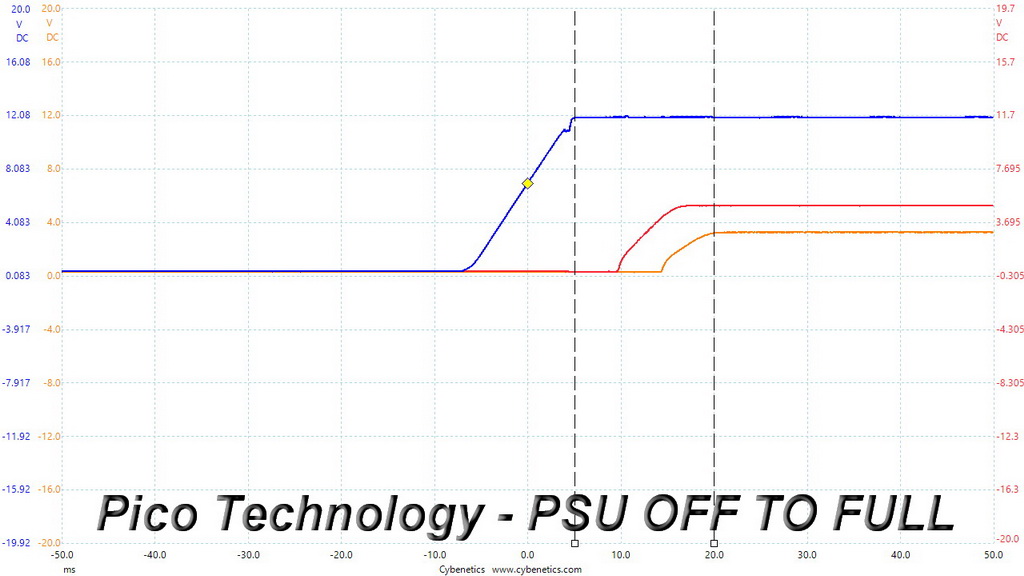Corsair CX450 PSU Review: Two Flavors, Tested and Compared
Why you can trust Tom's Hardware
Protection Features & DC Power Sequencing
Protection Features
Check out our PSUs 101 article to learn more about PSU protection features. We describe our protection features evaluation methodology in detail here.
| CX450 (CWT) Protection Features | |
|---|---|
| OCP | 12V: 45.2A (120.86%)5V: 32.15A (160.75%)3.3V: 33.85A (169.25%)5VSB: 5.8A (193.33%), 76mV Ripple |
| OPP | 542.026W (120.45%) |
| OTP | ✓ (175°C @ secondary side) |
| SCP | 12V: ✓5V: ✓3.3V: ✓5VSB: ✓-12V: ✓ |
| PWR_OK | Operates properly |
| NLO | ✓ |
| SIP | Surge: MOVInrush: NTC thermistor |
| CX450 (Great Wall) Protection Features | |
|---|---|
| OCP | 12V: 47.4A (126.74%), 12.018V 5V: 32.3A (161.5%), 4.998V 3.3V: 35.3A (176.5%), 3.312V 5VSB: 5.3A (176.67%), 4.919V |
| OPP | 567.995W (126.22%) |
| OTP | ✓ (190°C @ secondary side) |
| SCP | 12V: ✓ 5V: ✓ 3.3V: ✓ 5VSB: ✓ -12V: ✓ |
| PWR_OK | Operates properly |
| NLO | ✓ |
| SIP | Surge: MOV Inrush: NTC thermistor |
It was nice to see over-temperature protection present in these budget-oriented PSUs. Their power-good signals were also accurate (though hold-up time was low in both cases).Both PSUs sport protection features with similar thresholds. The only notable exception is the CWT model's 5VSB rail. OCP (over-current protection) was set pretty high, allowing ripple to get out of control.
DC Power Sequencing (CX450 - Great Wall)
According to Intel’s most recent Power Supply Design Guide (revision 1.4), the +12V and 5V voltages must be equal to or greater than the 3.3V rail’s output at all times.
For our first measurement, we turned the PSU off and switched it back on without any load. Next, we set the PSU to standby mode, dialed full load and then started the PSU. In the last test, while the PSU was completely off (we cut power or switched the PSU off), we dialed full load before restoring power.



MORE: Best Power Supplies
MORE: How We Test Power Supplies
MORE: All Power Supply Content
Get Tom's Hardware's best news and in-depth reviews, straight to your inbox.
Current page: Protection Features & DC Power Sequencing
Prev Page Efficiency, Temperature & Noise Next Page Cross-Load Tests & Infrared Images
Aris Mpitziopoulos is a contributing editor at Tom's Hardware, covering PSUs.
-
jpe1701 Oh thank you Aris, I've been waiting for a review of this. It's always low in price and tempting to recommend but there weren't any reviews.Reply -
Darkbreeze Why do both of the review summary boxes list the Great Wall version? Both the one on the front page and the last page are the same. Seems like you ought to include a summary box for both versions since there seems to be some major differences between them. And even more so since you seem to indicate the CWT version is the better unit, but only include a summary box for the Great Wall unit.Reply -
Darkbreeze I totally understand. No worries mate. Editorial has a bad habit of effectively pooping all over the independent contributors writing as well. Not surprising that they are doing so with your work, but I sure wish somebody in editorial would make a few changes to policy that keeps the finished product a bit more in line with what the contributor intended, which often they don't. In this case, it totally makes zero sense that they didn't leave it as you had it.Reply -
Rexper ReplyWe preferred CWT's version of Corsair's CX450, but that doesn't mean you should avoid Great Wall's
Not that we have a choice.
Great article, once again, Aris!
There is some controversy appearing relating to the fan bearings used in the CX450. JonnyGURU, who works at Corsair, claims both CX450 versions use a rifle bearing.
Unfortunately, we can't know for certain until someone dismantles the fan.
http://www.jonnyguru.com/forums/showthread.php?t=15943&page=2 -
Darkbreeze I don't think it even makes a tremendous amount of difference. Fan failure on power supplies due to bearing fatigue is the least of the issues I've usually seen in the past on older units. Plus, it's not terribly difficult to replace a PSU fan if you have at least of a modicum of common sense and don't possess four thumbs.Reply
If fan noise is the biggest worry, or bearing failure over the long term, then I'd say these are winners for the price point. Most would never hear them over the sound of the rest of the system in any case.